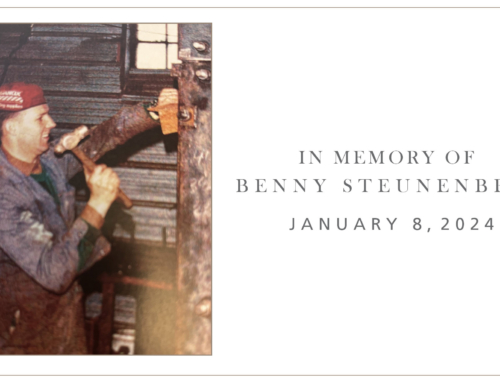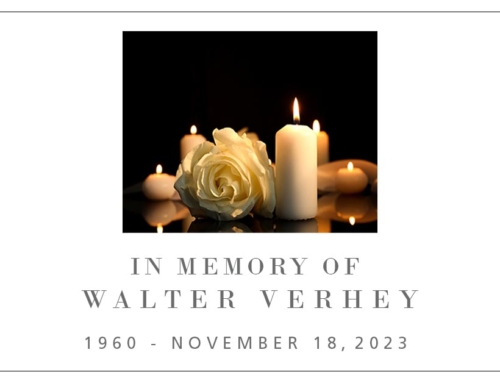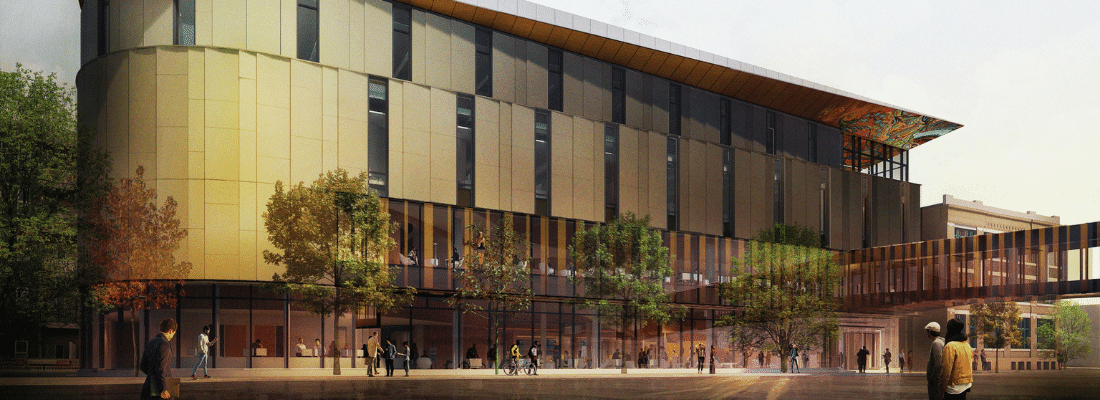
Innovation Centre, Red River College Building Exterior Credit: Diamond Schmitt
Steel Superstructure Creates Flexible, High-Tech Interactive Spaces
By: Matthew Bradford
Red River College is readying its Exchange District Campus for the arrival of its new Innovation Centre. Currently in construction by Winnipeg’s Akman Construction, the 80,000-sq.-ft. addition will house “re-imagined academic programs, innovations and entrepreneurial activities” in a net-zero environment. It will also include renovations to the adjacent Scott Fruit Building, which is connected to the new school by an above-ground steel pedestrian bridge.
The Innovation Centre is a joint venture between Number TEN Architectural Group and Diamond Schmitt Architects Inc. Together, the firms have designed a steel superstructure building that offers flexible, high-tech and interactive spaces in a stylish, modern atmosphere that “nurtures creativity and collaboration.”
“We wanted to create a space that embraced a new way of teaching and learning,” says Paul Vogt, President & CEO, Red River College. “[We wanted] a space that would bring together students with education and industry professionals, and a space that would embrace social innovation and enterprise and allow us to continue to focus on groundbreaking innovative research.”
“Number TEN and Diamond Schmitt embraced this vision and have turned it into reality,” he adds.
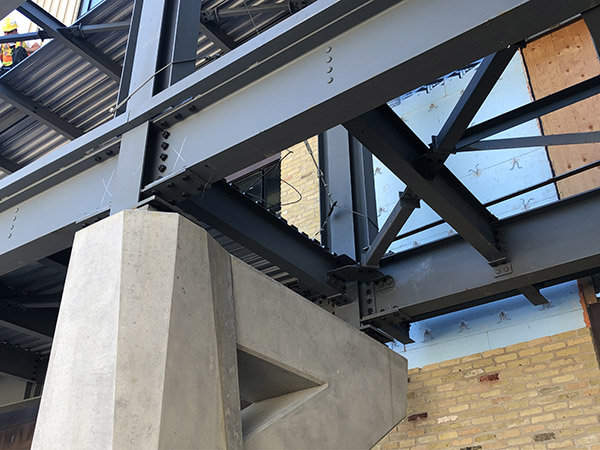
Credit: Abesco
A Collaborative Hub
Innovation is at the core of Number TEN and Diamond Schmitt’s designs. Standout features include a spacious central atrium (aka Agora), roundhouse auditorium, acoustically isolated space for performances, student collaboration zones and natural lighting throughout. Outside, the building is wrapped in photovoltaic glass that generates energy and changes colour according to weather and viewing angles.
“The steel superstructure provided the maximum flexibility in the planning and design of the building, not to mention that it is also a sustainable solution with long-term durability, high recycled content, and future adaptability,” notes Doug Hannah, Partner with Number TEN Architects.
Michael Leckman, Principal with Diamond Schmitt Architects, says the use of steel has also been instrumental in creating the look and feel of the new centre. Specifically, it has proven ideal for constructing the dramatic thin-edged cornice along the building’s south facade, providing a thinness and length of the cantilever that would not achieve the same results with another material. Furthermore, he adds, “Thanks to the ease of thermal bridging, the design is able to create a continuous line from the exterior cornice through to the interior event space on the fourth floor.”
Having Abesco Ltd. on the team has also proven beneficial. The Manitoba-based steel fabricator and CISC steel structures certified member’s expertise has been integral in creating key components such as the parapet cantilever at the front of the building; the centre’s elevator, which includes an exposed structure; and the steel pedestrian bridge connecting the centre to the neighbouring Scott Fruit Building. The evidence of their abilities led to the successful execution of their work.
Steel also features prominently throughout the interior of the new facility. For example, it has been used to achieve a column-free central Agora, which is framed with expressively slender two-storey intumescent painted columns and has edges suspended on the third and fourth floors from the roof on slender steel posts.
Additionally, the material formed the backbone for the Centre’s Roundhouse Auditorium, in which it has been used to fashion stepped beams for the acoustic details that ensure structural isolation of the centre’s major assembly space.
In addition to shaping (and framing) Red River College’s newest addition, choosing to work with steel has enabled the team to explore various means to bolster the building’s resilience and performance.
“In other words,” Leckman continues, “steel is an integral part of sustainable buildings, as more design opportunities – such as the dramatic cornice – are possible while achieving highly effective building envelopes.”
An Innovative Approach
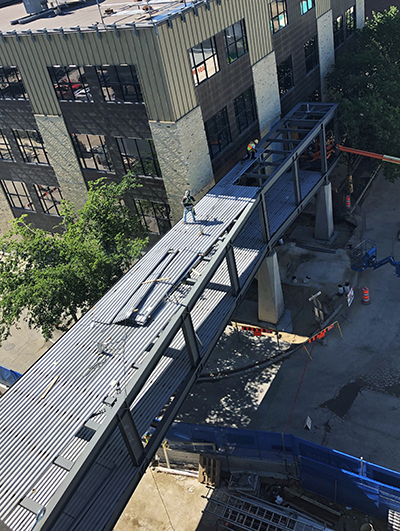
Credit: Abesco
Bringing the Innovation Centre online was no simple task. The centre’s ambitious design came with several challenges, such as keeping the steel connections hidden in wall cavities and fabricating the bent plates for the parapet in lengths that would suit the bending equipment. Renovating the existing heritage building, which is connected to the new roof, also required extensive field measurements in order to prepare precise structural framing to support the centre’s moveable partitions. Moreover, joists were prefabricated to accommodate certain site conditions, which necessitated immense coordination for the anchor locations between all project stakeholders.
“Communication with the team is key to all parts of a successful project, like this one,” says Gar Helm, Project Manager and Vice President of Operations with Abesco. “We never hesitated to contact the team and ask questions.” Gar adds that having a local detailing team also played a key role in the process.
Leckman agrees that while the Innovation Centre was a welcome challenge, it was made possible through strong partnerships from the start. “Collaboration between all team members on the Red River College project – including fabricators, construction managers, clients, engineers and designers – has been continuous, rigorous, essential for achieving a high-quality result.”
Construction on Red River College’s Innovation Centre is slated to wrap up shortly and the school is slated to welcome students later this fall.
Originally published in Advantage Steel No. 69




